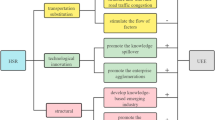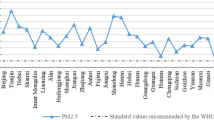Abstract
With the increase in haze pollution in Chinese cities, answering the question of whether using a high-speed rail (HSR) as a green and efficient transportation system can alleviate haze pollution in China has become a research hotspot. This study empirically tests the impact of HSR network construction on haze pollution and its spatial spillover effects. (1) The construction of a HSR would have a mitigation effect on haze pollution in node cities and surrounding cities, and the more developed the HSR is, the more significant that this effect would be. (2) Haze pollution persists for a long time, the haze pollution from the previous year may have a positive promoting effect on the haze pollution in the following year. (3) The use of a HSR reduces haze pollution by replacing traditional road transportation and promoting industrial structure upgrading and technological innovation. (4) The inhibitory effect of HSR use on haze pollution varies due to regional differences and variation in city size.








Similar content being viewed by others
Data availability
The datasets used or analyzed in this study are available from the corresponding author on reasonable request.
Notes
According to the Notice on Adjusting the Criteria for Adjusting the Scale of Cities that was issued by the State Council, 285 cities are divided into large cities and small and medium-sized cities with a population of 1 million as the standard.
References
Anas A, Lindsey R (2011) Reducing urban road transportation road pricing in theory and in practice. Rev Environ Econ Policy 5:66–88. https://doi.org/10.1093/reep/req019
Baron RM, Kenny DA (1986) The moderator-mediator variable distinction in social psychological research: conceptual, strategic, and statistical considerations. J Pers Soc Psychol 51(6):1173–1182. https://doi.org/10.1037/0022-3514.51.6.1173
Cai X, Lu Y, Wu M et al (2016) Does environmental regulation drive away inbound foreign direct investment? Evidence from a quasi-natural experiment in China. J Dev Econ 123:73–85. https://doi.org/10.1016/j.jdeveco.2016.08.003
Cai Ning CYWJ (2014) Green development and new urbanization of China: a dual- dimensional analysis based on SBM- DDF mode. J Beijing Normal Univ: Social Sci 5:130–139
Ćetković J, Lakić S, Bogdanović P, Vujadinović R, Žarković M (2020) Assessing environmental benefits from investment in railway infrastructure. Pol J Environ Stud 29(3):2125–2137. https://doi.org/10.15244/pjoes/109849
Chang Y, Lei S, Teng J, Zhang J, Zhang L, Xu X (2019) The energy use and environmental emissions of high-speed rail transportation in China: a bottom-up modeling. Energy 182:1193–1201. https://doi.org/10.1016/j.energy.2019.06.120
Chen Y (2020) Recent developments of fluorescent probes for detection and bioimaging of nitric oxide. Nitric Oxide 98:1–19. https://doi.org/10.1016/j.niox.2020.02.002
Chen C, Hall P (2012) The wider spatial-economic impacts of high-speed trains: a comparative case study of Manchester and Lille sub-regions. J Transp Geogr 24:89–110. https://doi.org/10.1016/j.jtrangeo.2011.09.002
Dowlatabadi H, Oravetz MA (2006) US long-term energy intensity: backcast and projection. Energ Policy 34(17):3245–3256. https://doi.org/10.1016/j.enpol.2005.05.018
Fan X, Xu Y (2020) Convergence on the haze pollution: city-level evidence from China. Atmos Pollut Res 11(6):141–152. https://doi.org/10.1016/j.apr.2020.03.004
Fang J (2021) Impacts of high-speed rail on urban smog pollution in China: a spatial difference-in-difference approach. Sci Total Environ 777:146153. https://doi.org/10.1016/j.scitotenv.2021.146153
Feng Han YX (2017) Has the agglomeration of productive service industries reduced carbon emissions---spatial measurement analysis of panel data of cities at the prefecture level and above in China. Quant technic econ res (3). https://doi.org/10.13653/j.cnki.jqte.2017.03.003
Fritz MS, MacKinnon DP (2007) Required sample size to detect the mediated effect. Psychol Sci 18(3):233–239. https://doi.org/10.1111/j.1467-9280.2007.01882.x
Fu S, Gu Y (2017) Highway toll and air pollution: evidence from Chinese cities. J Environ Econ Manag 83:32–49. https://doi.org/10.1016/j.jeem.2016.11.007
Gan T, Liang W, Yang H, Liao X (2020) The effect of economic development on haze pollution (PM2.5) based on a spatial perspective: urbanization as a mediating variable. J Clean Prod 266:121880. https://doi.org/10.1016/j.jclepro.2020.121880
Givoni M (2007) Environmental benefits from mode substitution: comparison of the environmental impact from aircraft and high-speed train operations. Int J Sustain Transp 1(4):209–230. https://doi.org/10.1080/15568310601060044
Guangzhao Sun KH (2019) Analysis of the heterogeneous impact of high-speed rail opening on total factor productivity growth rate. J Financ Econ 45(5). https://doi.org/10.16538/j.cnki.jfe.2019.05.007
Guo X, Sun W, Yao S, Zheng S (2020) Does high-speed railway reduce air pollution along highways? —— evidence From China. Transp Res Part D: Transp Environ 89:102607. https://doi.org/10.1016/j.trd.2020.102607
Hao Y, Liu Y (2016) The influential factors of urban PM2.5 concentrations in China: a spatial econometric analysis. J Clean Prod 112:1443–1453. https://doi.org/10.1016/j.jclepro.2015.05.005
Huang G, Zhang J, Yu J, Shi X (2020) Impact of transportation infrastructure on industrial pollution in Chinese cities: a spatial econometric analysis. Energy Econ 92:104973. https://doi.org/10.1016/j.eneco.2020.104973
Islam N (1995) Growth empirics a panel data approach. Q J Econ. https://doi.org/10.2307/2946651
Janic (2003) Engineers, Part F: Journal of Rail and Rapid Proceedings of the Institution of Mechanical. J Rail Rapid Transit:217–259. https://doi.org/10.1243/095440903322712865
Jin Lu ,Yang Chen,Xiaoli He (2012) Innovation, economic growth and transformation dynamics – an empirical analysis based on Shandong Province. Econ Surv (2). https://doi.org/10.15931/j.cnki.1006-1096.2012.02.011
Lelieveld J, Evans JS, Fnais M, Giannadaki D, Pozzer A (2015) The contribution of outdoor air pollution sources to premature mortality on a global scale. Nature 525(7569):367–371. https://doi.org/10.1038/nature15371
Li J, Luo N (2020) Has the opening of high-speed rail alleviated the level of air pollution in cities? China Econ Quart 4(19). https://doi.org/10.13821/j.cnki.ceq.2020.03.09
Li J, Li F, Li J (2022) Does new-type urbanization help reduce haze pollution damage? Evidence from China’s county-level panel data. Environ Sci Pollut Res 29:47123–47136. https://doi.org/10.1007/s11356-022-19272-1
Lin C, Liu J, Li W (2021) Influence of the high-speed railway (HSR) construction on industrial structure transformation. Enterprise information systems ahead-of-print(ahead-of-print). 1-23. https://doi.org/10.1080/17517575.2021.1942998.
Lu M (2017) Urban, regional and national development – the present and future of spatial political economy. China Econ Quart 4(16). https://doi.org/10.13821/j.cnki.ceq.2017.03.11
Ministry Of Environment Protection (2021) Communiqué on the State of China's Ecology and Environment
Peng JWX (2019) High-speed rail construction and green total factor productivity—based on the distorted perspective of factor. China Popul Resour Environ 11(29). https://doi.org/10.12062/cpre.20190516
Scholz MSAR (2005) Life cycle inventories of transport services: background data for freight transport. Int J Life Cycle Assess 1(10):85–94. https://doi.org/10.1065/lca2004.10.181.10
Shao S, Tian Z, Yang L (2017) High speed rail and urban service industry agglomeration: evidence from China’s Yangtze River Delta region. J Transp Geogr 64:174–183. https://doi.org/10.1016/j.jtrangeo.2017.08.019
Shao S, Li X, Cao J (2019) China’s urbanization and smog control. Econ Res 2
Smith RA (2003) Railways: how they may contribute to a sustainable future. Eng, Part F: J Rail Rapid Proceedings Institution Mech 217-43. https://doi.org/10.1243/095440903322712847
Shi D, Li G, Liu J (2020) Informatization impact, transaction cost and enterprise TFP: a natural experiment based on national smart city construction. Finance Trade Econ 41(03):117–130. https://doi.org/10.19581/j.cnki.ciejournal.2018.06.008
Song M, Zheng W, Wang Z (2016) Environmental efficiency and energy consumption of highway transportation systems in China. Int J Prod Econ 181:441–449. https://doi.org/10.1016/j.ijpe.2015.09.030
Sui ZXSY, Zhang Y (2021) The cytotoxicity of PM2.5 and its effect on the secretome of normal human bronchial epithelial cells. Res Square. https://doi.org/10.21203/rs.3.rs-1055836/v1
Wenhao Sun JZ (2021) The operation of high-speed rail promotes the improvement of urban total factor productivity. Shanghai Econ Res (1). https://doi.org/10.19626/j.cnki.cn31-1163/f.2021.01.008
Wang L, Xie Q, Xue F (2022) Zongxin Li.2020.Does smart city construction reduce haze pollution? J Environ Res Public Health 19:16421. https://doi.org/10.3390/ijerph192416421
Zhonglin Wen,Baojuan Ye (2014) Mediation effect analysis: method and model development. Adv Psychol Sci 22(5):731–745. https://doi.org/10.3724/SP.J.1042.2014.00731
Yan J, Zhao J, Yang X, Xufeng S, Wang H, Ran Q (2020) Does low-carbon city pilot policy alleviate urban haze pollution? Empirical evidence from a quasi-natural experiment in China. J Environ Res Public Health 2021(18):11287. https://doi.org/10.3390/ijerph182111287
Yao S, Zhang F, Wang F, Ou J (2019) High-speed rail and urban economic growth in China after the global financial crisis. Chin World Econ 27(2):44–65. https://doi.org/10.1111/cwe.12274
Ye Xuan YY (2017) Research on the improvement of total factor productivity of manufacturing enterprises by the agglomeration of productive service industries. Quant technical econ res 2. https://doi.org/10.13653/j.cnki.jqte.2017.02.006
Yumeng Pang ZLYP (2020) The spatial correlation effect between financial science and education expenditure and smog pollution 37(6)   https://doi.org/10.15931/j.cnki.1006-1096.2020.06.008.
Zhang F, Wang F, Yao S (2021) High-speed rail accessibility and haze pollution in China: a spatial econometrics perspective. Transp Res Part D: Transp Environ 94:102802. https://doi.org/10.1016/j.trd.2021.102802
Zhao M, Liu X, Derudder B, Zhong Y, Shen W (2015) Mapping producer services networks in Mainland Chinese cities. Urban Stud 52(16):3018–3034. https://doi.org/10.1177/0042098014558541
Zhou T, Zhang N (2022) Does high-speed rail make firms cleaner in China? J Environ Manag 311:114901. https://doi.org/10.1016/j.jenvman.2022.114901
Funding
This work was supported by the National Fund of Philosophy and Social Science of China (Grant No. 23BGL316).
Author information
Authors and Affiliations
Contributions
ZQL: data curation, formal analysis, writing—original draft, writing—review and editing.
SJG: data curation, formal analysis.
WL: project administration, funding acquisition, conceptualization, supervision.
All authors read and approved the final manuscript.
Corresponding author
Ethics declarations
Ethics approval
The manuscript has not been published elsewhere in part or in entirely.
Consent for publication
All the authors contributed materially to this study, have reviewed and approved the manuscript, and agree with submission and publication to the journal.
Competing interests
The authors declare no competing interests.
Additional information
Responsible Editor: Philippe Garrigues
Publisher’s note
Springer Nature remains neutral with regard to jurisdictional claims in published maps and institutional affiliations.
Rights and permissions
Springer Nature or its licensor (e.g. a society or other partner) holds exclusive rights to this article under a publishing agreement with the author(s) or other rightsholder(s); author self-archiving of the accepted manuscript version of this article is solely governed by the terms of such publishing agreement and applicable law.
About this article
Cite this article
Luan, Z., Guo, S. & Liang, W. Can the construction of a high-speed rail alleviate haze pollution: an empirical analysis based on social networks and dynamic spatial econometric models. Environ Sci Pollut Res 31, 14990–15006 (2024). https://doi.org/10.1007/s11356-024-31845-w
Received:
Accepted:
Published:
Issue Date:
DOI: https://doi.org/10.1007/s11356-024-31845-w




